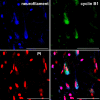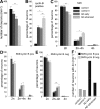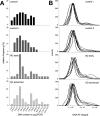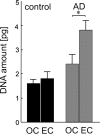Aneuploidy and DNA replication in the normal human brain and Alzheimer's disease
- PMID: 17596434
- PMCID: PMC6672221
- DOI: 10.1523/JNEUROSCI.0379-07.2007
Aneuploidy and DNA replication in the normal human brain and Alzheimer's disease
Abstract
Reactivation of the cell cycle, including DNA replication, might play a major role in Alzheimer's disease (AD). A more than diploid DNA content in differentiated neurons might alternatively result from chromosome mis-segregation during mitosis in neuronal progenitor cells. It was our objective to distinguish between these two mechanisms for aneuploidy and to provide evidence for a functional cell cycle in AD. Using slide-based cytometry, chromogenic in situ hybridization, and PCR amplification of alu-repeats, we quantified the DNA amount of identified cortical neurons in normal human brain and AD and analyzed the link between a tetraploid DNA content and expression of the early mitotic marker cyclin B1. In the normal brain, the number of neurons with a more than diploid content amounts to approximately 10%. Less than 1% of neurons contains a tetraploid DNA content. These neurons do not express cyclin B1, most likely representing constitutional tetraploidy. This population of cyclin B1-negative tetraploid neurons, at a reduced number, is also present in AD. In addition, a population of cyclin B1-positive tetraploid neurons of approximately 2% of all neurons was observed in AD. Our results indicate that at least two different mechanisms need to be distinguished giving rise to a tetraploid DNA content in the adult brain. Constitutional aneuploidy in differentiated neurons might be more frequent than previously thought. It is, however, not elevated in AD. In addition, in AD some neurons have re-entered the cell cycle and entirely passed through a functional interphase with a complete DNA replication.
Figures








Similar articles
-
Cell cycle activation and aneuploid neurons in Alzheimer's disease.Mol Neurobiol. 2012 Aug;46(1):125-35. doi: 10.1007/s12035-012-8262-0. Epub 2012 Apr 13. Mol Neurobiol. 2012. PMID: 22528601 Review.
-
Aneuploidy in the normal, Alzheimer's disease and ataxia-telangiectasia brain: differential expression and pathological meaning.Neurobiol Dis. 2009 May;34(2):212-20. doi: 10.1016/j.nbd.2009.01.003. Epub 2009 Jan 21. Neurobiol Dis. 2009. PMID: 19344645
-
Aberrant expression of mitotic cdc2/cyclin B1 kinase in degenerating neurons of Alzheimer's disease brain.J Neurosci. 1997 May 15;17(10):3588-98. doi: 10.1523/JNEUROSCI.17-10-03588.1997. J Neurosci. 1997. PMID: 9133382 Free PMC article.
-
Regional mosaic genomic heterogeneity in the elderly and in Alzheimer's disease as a correlate of neuronal vulnerability.Acta Neuropathol. 2015 Oct;130(4):501-10. doi: 10.1007/s00401-015-1465-5. Epub 2015 Aug 23. Acta Neuropathol. 2015. PMID: 26298468
-
Aneuploidy, chromosomal missegregation, and cell cycle reentry in Alzheimer's disease.Acta Neurobiol Exp (Wars). 2009;69(2):232-53. doi: 10.55782/ane-2009-1748. Acta Neurobiol Exp (Wars). 2009. PMID: 19593337 Review.
Cited by
-
Genetic evidence for p75NTR-dependent tetraploidy in cortical projection neurons from adult mice.J Neurosci. 2013 Apr 24;33(17):7488-500. doi: 10.1523/JNEUROSCI.3849-12.2013. J Neurosci. 2013. PMID: 23616554 Free PMC article.
-
Single-cell whole genome sequencing reveals no evidence for common aneuploidy in normal and Alzheimer's disease neurons.Genome Biol. 2016 May 31;17(1):116. doi: 10.1186/s13059-016-0976-2. Genome Biol. 2016. PMID: 27246599 Free PMC article.
-
Rapid initiation of cell cycle reentry processes protects neurons from amyloid-β toxicity.Proc Natl Acad Sci U S A. 2021 Mar 23;118(12):e2011876118. doi: 10.1073/pnas.2011876118. Proc Natl Acad Sci U S A. 2021. PMID: 33737393 Free PMC article.
-
Cell cycle activation and aneuploid neurons in Alzheimer's disease.Mol Neurobiol. 2012 Aug;46(1):125-35. doi: 10.1007/s12035-012-8262-0. Epub 2012 Apr 13. Mol Neurobiol. 2012. PMID: 22528601 Review.
-
The role of structural variations in Alzheimer's disease and other neurodegenerative diseases.Front Aging Neurosci. 2023 Feb 8;14:1073905. doi: 10.3389/fnagi.2022.1073905. eCollection 2022. Front Aging Neurosci. 2023. PMID: 36846102 Free PMC article. Review.
References
-
- Arendt T. Alzheimer's disease as a disorder of mechanisms underlying structural brain self-organization. Neuroscience. 2001;102:723–765. - PubMed
-
- Arendt T, Rodel L, Gartner U, Holzer M. Expression of the cyclin-dependent kinase inhibitor p16 in Alzheimer's disease. NeuroReport. 1996;7:3047–3049. - PubMed
-
- Arendt T, Holzer M, Gartner U. Neuronal expression of cycline dependent kinase inhibitors of the INK4 family in Alzheimer's disease. J Neural Transm. 1998;105:949–960. - PubMed
-
- Arendt T, Holzer M, Stobe A, Gartner U, Luth HJ, Bruckner MK, Ueberham U. Activated mitogenic signaling induces a process of dedifferentiation in Alzheimer's disease that eventually results in cell death. Ann NY Acad Sci. 2000;920:249–255. - PubMed
-
- Batzer MA, Deininger PL. Alu repeats and human genomic diversity. Nat Rev Genet. 2002;3:370–379. - PubMed
Publication types
MeSH terms
Substances
LinkOut - more resources
Full Text Sources
Other Literature Sources
Medical
Miscellaneous
